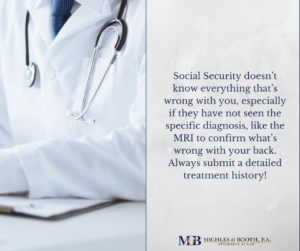The last thing you want to hear is that your application for Social Security Disability or Supplemental Security Income has been denied because of an avoidable mistake. We often talk with clients who attempted to file on their own and made one of these 3 mistakes. Even with the help of a lawyer, it can be difficult to impossible to correct that mistake.
These three mistakes can be made on both the application for SSD or SSI and can be very detrimental to the case. They are difficult to fix and sometimes cannot be fixed.
 Waiting Too Long To Apply
Waiting Too Long To Apply
One of the mistakes that cannot be fixed is waiting too long to apply. This is one that unfortunately I see all the time. The way Social Security disability insurance works is that, in order to be eligible for benefits, you have what’s called a “date last insured.” What that means is, you have to apply for Social Security disability insurance within five years of the last day you worked.
Your date last insured is five years after you stopped working; so, if you wait six years to apply for benefits, you’re past your date last insured. I get people all the time that say, “I didn’t know. I’ve worked for 40 years, what do you mean I haven’t paid into the system?” Well, it’s not that you haven’t paid into the system, you have and are eligible for retirement once you’re 66 or 67. But for disability, if you wait more than five years to apply, you’re without SSD insurance. It’s just like you didn’t pay your premiums for Blue Cross and Blue Shield. You don’t have insurance anymore.
So rule number one: don’t wait too long to apply. Once you stop working, you apply. If you’re denied you need to appeal that denial. You need to get to an attorney and have the attorney appeal, or get yourself down to the Social Security office and appeal it yourself because if you do not appeal, that decision becomes final and your five years is running. So rule number one: do not wait too long to apply.
Padding Your Resume
The second big mistake that I see all the time is padding your resume. A lot of the times, people’s resumes aren’t really accurate representations of what they did at work, which is understandable. They’ll put things like they were a lead worker or a manager or an assistant manager when maybe that wasn’t exactly what they really did.
The problem with Social Security is that one of the things they’re looking for is transferable skills. Here is an example. So if you worked as a stocker at Tom Thumb and if you tell the Social Security Administration that you were an assistant manager, because Tom Thumb calls new employees assistant managers, Social Security Administration will deny your claim because they’ll say you have transferable skills to sedentary managerial work. And your response will be, “I don’t have any management experience, I can’t do a desk job.” And Social Security says, “Oh, you may not have been doing a desk job, but you have transferable skills to a desk job, so you’re not disabled.”
 That’s an example of one that can never be fixed. Once you’ve opened the Pandora’s box of you are management, that you had an easy sit-down job with skills that transfer across many, many jobs, we can’t put the cat back in the box. It’s done. You have transferable skills, and disability becomes very difficult to obtain.
That’s an example of one that can never be fixed. Once you’ve opened the Pandora’s box of you are management, that you had an easy sit-down job with skills that transfer across many, many jobs, we can’t put the cat back in the box. It’s done. You have transferable skills, and disability becomes very difficult to obtain.
So when you’re applying for disability, do not pad your resume. Tell them what you actually did. Do not exaggerate what you are capable of doing. Do not tell them you had a lot of computer skills just because you know how to open a word document. Do not tell them you were management unless you could hire and fire without coordinating with anyone else. So just as a warning, do not pad the resume. A good rule of thumb.
Incomplete Treatment History
And the last, third mistake is incomplete treatment history. This is one that we usually can fix. People will start their application without getting all their documentation ready. They’ll list one or two doctors, and they’ll forget about hospital visits they’ve had or diagnostics like x-rays or MRIs that they went to. They’ll ask Social Security to accept them on an incomplete treatment history.
Social Security doesn’t know everything that’s wrong with you, especially if they have not seen the specific diagnosis, like the MRI to confirm what’s wrong with your back. Your back hurts, but they don’t know that you have a bulging disc or that you have a specific condition in your back that’s causing the back pain without the MRI or specific diagnosis could prove it.
So make sure that when you apply that you know all the doctors, all the medical professionals, and all the places that you’ve been that gave you medical treatment for at least one or two years before you stopped working, all the way up through the day that you’re applying. You’re going to want a thorough list, of all your medications, all your diagnostics, all your doctors.
Now, this mistake is one we can fix, if we remember it later we can get it submitted to the judge. The judge says, “Oh, well this wasn’t in before, this makes it much easier.” We can win those; we can fix that, unlike the padded resumes and going past your date last insured which we cannot fix.
Get help today!
Applying for disability can be a confusing, time-consuming process. If you have any questions about the application process or are considering hiring an attorney to help you, please don’t hesitate to give us a call. We always have free no obligation consultations. Give us a call at (800) 848-6168

View the related video here:
View the related slidedeck:SSD – Three Common Application Mistakes
.jpg)
.jpg)